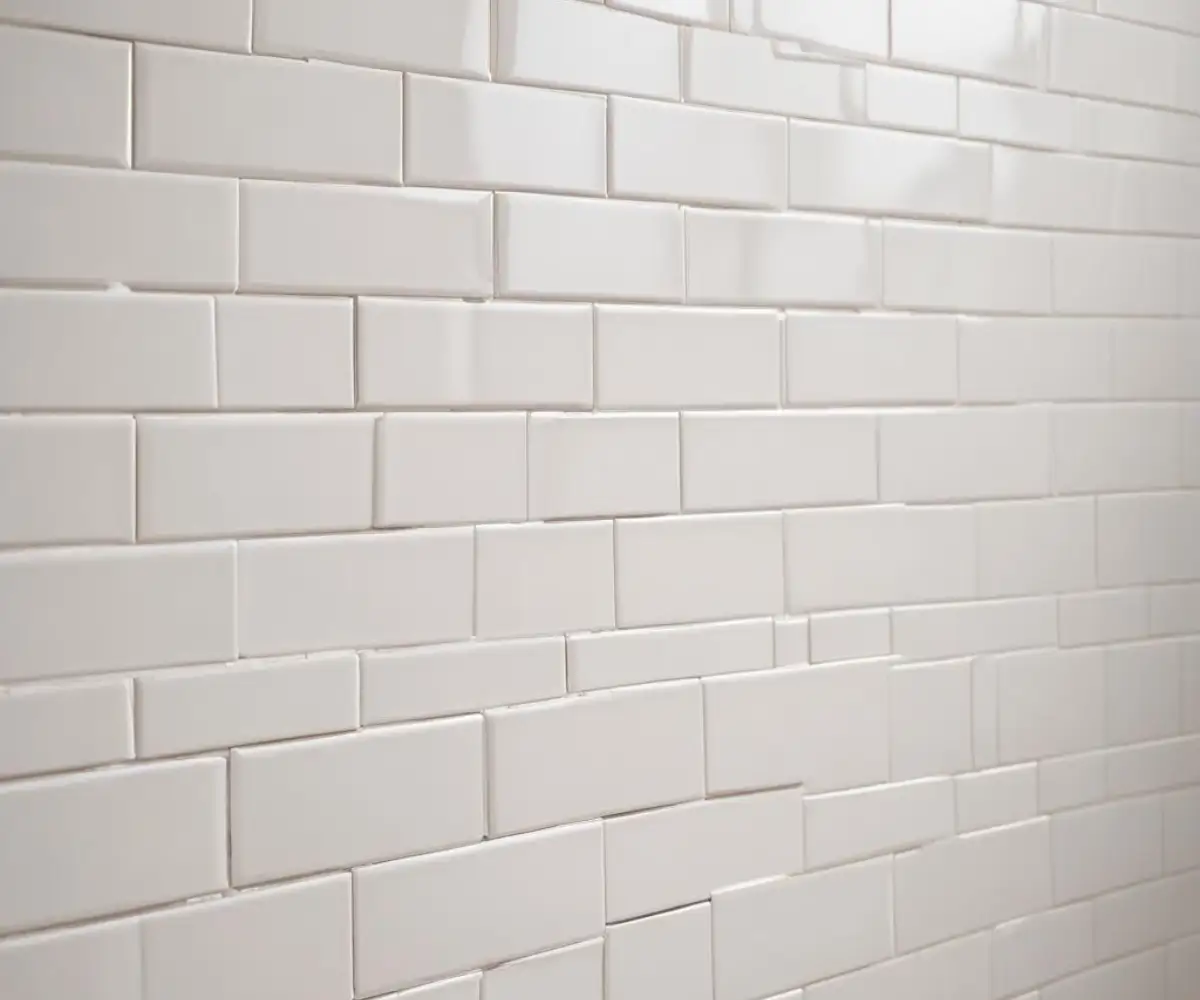Subway Tile No Spacers: The Secret to a Flawless, Modern Finish
The dream of a seamless, monolithic subway tile wall is a powerful one. It evokes images of historic New York City subway stations and clean, contemporary designs. This desire often leads to a tempting question: can you install subway tile with no spacers to achieve that perfect, super-tight look?
While technically possible, attempting to install subway tile without any gap is a high-risk endeavor that often leads to disappointing results. The real secret isn’t about eliminating the space entirely, but understanding how to achieve the thinnest possible grout line for a professional, durable finish. This guide will demystify the process and reveal the professional techniques for getting that coveted no-spacer appearance without compromising the integrity of your installation.
You'll Learn About
Why Ditch the Spacers? The Allure of the Minimalist Look
The primary motivation for skipping tile spacers is aesthetic. A minimal grout line, typically 1/16th of an inch, creates a clean, uniform surface that makes a space feel more expansive. This look allows the tile itself—its color, texture, and pattern—to be the star of the show, rather than the grid of grout lines.
In modern and minimalist designs, tight grout lines contribute to a sleek, uninterrupted visual plane. For classic or vintage aesthetics, this technique mimics the original installations found in historic buildings, lending an air of authenticity. The goal is to create a wall that appears as a single, cohesive surface, and reducing the visual impact of grout is the key to achieving this effect.
The Hidden Dangers: What Really Happens When You Skip Spacers
Simply butting tiles together without any spacing is a recipe for disaster. Grout is not just a filler; it’s a crucial structural component of any tile installation. Attempting a true “no-spacer” job with standard tiles invites a host of problems that can ruin your project both aesthetically and functionally.
Without a designated gap, it’s nearly impossible to maintain perfectly straight and consistent lines. Tiles are rarely perfectly uniform, and even tiny variations in size will compound across a wall, resulting in wavy, unprofessional-looking lines. Furthermore, buildings naturally shift and materials expand and contract with temperature changes. A grout joint acts as a cushion for this movement; without it, the stress can cause tiles to crack, pop loose, or even tent off the wall. This can turn a seemingly simple project into a costly repair job.
The “No-Spacer” Illusion: Understanding Self-Spacing Tiles
Herein lies the most critical secret that separates professional results from DIY failures: the concept of the “no-spacer” look is often a misunderstanding. Most modern subway tiles are designed to be self-spacing. These tiles have small nubs or lugs on their edges that automatically create a consistent, minimal gap—usually 1/16th of an inch—when stacked together.
This built-in feature is the proper way to achieve that highly desired seamless look. You are not actually installing with “no spacers”; the spacers are integrated into the tile itself. This ensures there is just enough room for grout to penetrate and form a strong, protective bond while maintaining a visually minimal line. Many DIY installers are unaware of this feature and create problems by trying to force tiles together that are already designed for a perfect, tiny gap.
How to Identify Self-Spacing Subway Tiles
Before you begin your project, it’s essential to determine if your chosen tiles are self-spacing. Carefully examine the edges of a tile. You should be able to see and feel small, raised bumps or ridges. These are the lugs that will create the automatic spacing.
If you’re unsure, check the product description or manufacturer’s specifications, which will often state if the tiles are “lugged” or “rectified” with self-spacing features. When in doubt, you can do a quick dry-fit by stacking a few tiles on a flat surface to see how the lugs interact and the size of the gap they create. This simple check can save you from major installation headaches.

The Right Way to Achieve the Minimal Grout Line Look
Achieving a professional-looking subway tile installation with hairline grout lines requires precision and the correct methodology. It’s not about skipping steps, but about executing each step perfectly. Following this process ensures a beautiful, durable result that captures the “no-spacer” aesthetic correctly.
Step 1: Surface Preparation is Everything
The foundation of a flawless tile job is a perfectly flat, stable, and clean wall. Any imperfections in the surface will be magnified when using minimal grout lines. Use a long level or straightedge to check the wall for high and low spots. Address any dips with a patching compound and sand down any bumps.
For wet areas like showers, proper waterproofing is non-negotiable. This is as critical as ensuring the surface is level. Meticulous preparation at this stage prevents much larger problems, like uneven tiles and installation failure, down the line. A perfectly prepared surface is the first step toward professional-quality work.
Step 2: Choose the Right Tile and Mortar
As discussed, selecting self-spacing subway tiles is the most important choice for this type of project. Beyond that, consider the material. Ceramic and porcelain tiles are often more uniform than natural stone, which makes them better suited for tight grout lines. For your adhesive, choose a high-quality, non-sag thin-set mortar, especially for wall applications, to prevent tiles from sliding before they set.
Step 3: Perfecting Your Installation Technique
Begin by establishing a perfectly level guideline for your first row of tiles. This is the most critical row, as it will dictate the alignment of the entire wall. Apply the thin-set mortar to the wall with a notched trowel, combing it in even lines.
Set each tile firmly into the mortar with a slight twist to ensure full contact. As you stack the tiles, allow the built-in lugs to rest directly on the tiles below them. Even with self-spacing tiles, it’s wise to check your lines with a level every few rows to ensure everything remains perfectly horizontal and plumb.
Step 4: Grouting the Hairline Gap
For grout joints that are 1/8th of an inch or smaller, you must use unsanded grout. Sanded grout contains aggregates that are too large to fit into such a narrow space and can scratch the tile surface. Mix the grout to a consistency slightly thinner than peanut butter, ensuring it’s not too watery.
Apply the grout using a grout float held at a 45-degree angle, pressing it firmly into the joints from multiple directions to avoid air pockets. Precision is key; sometimes a small, tricky application can feel like you’ve made a mistake, similar to when you cut a caulk tube too big, but patience and careful application will pay off. After allowing the grout to set slightly (check manufacturer instructions), use a damp sponge to gently clean the excess grout off the tile faces.
Key Differences in Installation Approaches
Understanding the nuances between different installation methods can help you choose the right path for your project. The table below outlines the critical differences between a flawed “no-spacer” attempt and a professional “minimal grout line” installation.
| Aspect | Incorrect “No Spacer” Method | Professional “Minimal Grout Line” Method |
|---|---|---|
| Tile Type | Standard, non-lugged tiles pushed together. | Self-spacing (lugged) tiles are used to create an automatic gap. |
| Grout Gap | Inconsistent and often non-existent, preventing proper grout penetration. | A consistent, planned 1/16″ gap created by the tile’s design. |
| Grout Type | Often overlooked; difficult to apply any grout effectively. | Unsanded grout is required to fill the narrow joints properly. |
| Structural Integrity | Very poor. High risk of tile cracking, shifting, and failure. | Excellent. Grout joint allows for movement and strengthens the entire installation. |
| Aesthetic Result | Sloppy, with wavy lines and visible size discrepancies. | Clean, uniform, and professional with razor-thin, straight lines. |
| Long-Term Durability | Low. Prone to water damage, loose tiles, and crumbling grout. | High. A properly grouted installation is waterproof and built to last. |
When You Absolutely Must Use Spacers
While the minimal grout line look is popular, it’s not suitable for every situation. In certain cases, using traditional tile spacers to create a wider grout line (typically 1/8th of an inch) is not just a stylistic choice but a technical necessity. Ignoring this can lead to a failed installation.
You should always use spacers when working with handmade or irregular tiles. These tiles have intentional variations in size and shape that make tight grout lines impossible; a wider grout line helps absorb and hide these inconsistencies. Likewise, if you’re tiling over a surface that isn’t perfectly flat, a wider grout line is more forgiving of imperfections. Sometimes, a wider, contrasting grout line is a deliberate design choice to create a bold, graphic pattern, an aesthetic decision as impactful as replacing wrought iron porch columns to change a home’s exterior style.
Sealing and Maintaining Minimal Grout Lines
Even the thinnest grout lines require proper care to stay looking clean and new. Once your grout has fully cured (typically after 72 hours), it’s crucial to apply a quality grout sealer. This creates a protective barrier that repels water, dirt, and stains, which is especially important in high-moisture areas like bathrooms or kitchens.
The final details, like sealing, ensure the longevity of the entire system. This same attention to detail applies to finishing touches around tubs and showers. In those areas, ensuring a waterproof seal might involve other techniques, such as learning how to glue trim to a bathtub to create a clean, watertight edge. Regular cleaning with a pH-neutral cleaner will keep your minimalist masterpiece looking pristine for years to come.
Is the No-Spacer Subway Tile Trend Right for Your Project?
The allure of a subway tile wall with no visible spacers is undeniable, offering a clean and sophisticated finish. However, the key takeaway is that this look is not achieved by eliminating the gap, but by embracing tiles specifically designed for it. The “secret” is using self-spacing tiles that create a perfect, minimal 1/16-inch joint.
This method requires a higher degree of precision, a perfectly prepared surface, and the right materials, particularly unsanded grout. While a more forgiving 1/8-inch grout line using standard spacers may be a better choice for beginners or for use with irregular tiles, mastering the minimal grout line technique can elevate your project to a truly professional level. By understanding the principles behind the “no-spacer” illusion, you can confidently create a durable and stunning tile installation that embodies timeless style.

